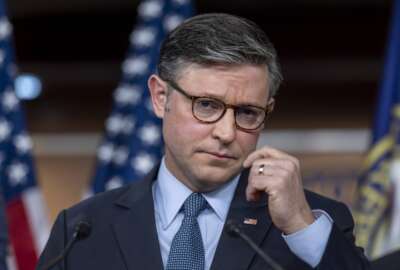Ruling on E-Verify could contain hidden costs
Now that the U.S. District Court has ruled that E-Verify mandates can move forward, some contractors might be left wondering how they will foot the bill.
wfedstaff | June 2, 2015 11:10 pm
By Dorothy Ramienski
Internet Editor
FederalNewsRadio
The Department of Homeland Security did not break the law when it mandated that contractors had to use E-Verify to make sure their employees are legally in the country.
And that might prove costly for some contractors looking to do business with the federal government.
The ruling (pdf) was handed down in a federal court last week by the U.S. District Court for Maryland.
The E-Verify mandate has been on hold for about eight months.
Initially, the Obama Administration said it wanted to review the rules and then the U.S. Chamber of Commerce sued.
David Fortney is a partner with the D.C, law firm Fortney & Scott and brought analysis to the Daily Debrief.
He began by explaining there is the potential for an appeal, though the regulations would go into effect unless a stay was issued by a court.
This, he said, might leave some federal contractors bidding for contracts worth over $100,000 a bit concerned about what to do.
“In the current status, [E-Verify] goes into effect on Sept. 8. At that point, generally speaking, all new government contracts or all amendments to government contracts will seek to incorporate a provision requiring the E-Verify obligation to be conducted.”
Thus, the onus falls on the contractor to make sure he or she is complying with the law.
“Essentially the employers will now be obligated under these requirements to run the E-Verify process, not just for the newly hired employees, which could be done today on a voluntary basis, but also for all current employees working on the contracts — any employee that’s been employed on or after Nov. 6, 1986.”
Fortney said that date is far from arbitrary. He explained that it was when the Immigration Reform Control Act went into effect.
“So, as a practical matter, employers that have long standing employees working on federal contracts — been with them for 20 or 25 years — are now going to need to reconfirm, using the E-Verify databases, that those employees are, in fact, eligible to work.”
When it comes to subcontractors, Fortney said the E-Verify system envisions a scenario where the initial contractor includes a clause in the contract for the subcontractor to ensure the legality of all employees.
“There’s what’s called a flowdown clause under which the subcontractor is obliged to perform those checks. That being said, the way the regulations are worded — the ultimate responsibility — the prime contractor cannot rid itself or transfer the ultimate responsibility to its subcontractor.”
There is also a burden placed on contracting officials at federal agencies, who will also be expected to include such clauses that relate to E-Verify in the contracts.
As far as following up, Fortney said there are a number of ways in which that will occur.
“The Department of Homeland Security’s [ICE] will be conducting compliance audits on site and they have indicated that and additional resources have been provided to conduct those audits. These will be audits focusing specifically on E-Verify. Additional agencies that already routinely are in the workplace auditing employers’ records, such as the Office of Federal Contract Compliance Programs and Wage Hour — both Labor Department agencies — also will be reviewing I-9 forms and related records and sharing that information back to ICE under agency sharing agreements.”
Fortney said that this will create more work for the employer, mainly because information changes over time and the requirements outlined on an I-9 form don’t necessarily match up with those specified by E-Verify.
“I think one of the real hidden costs that has not been really focused on much is that many employers are going to face a two-step process — step one, updating the I-9 information for their current employees and then, step two, collecting the data on the E-Verify forms and submitting that electronically to the database.”
The penalties for non-compliance range from fines to criminal penalties.
One of the more likely punishments, though, would involve debarment — the removal of a contractor’s eligibility to either complete his current contract or bid for new ones.
Another hurdle that Fortney said would be especially burdensome has to do with what’s called preliminary non-verification of an employee’s eligibility to work.
“This I think is a trap for the unwary because many of the employers may be thinking their doing what should be done — that is, if they’ve gotten something back from the government saying this individual is not eligible to work, [the contractor] says, ‘Well, we’d better put that person on hold — not have him work until we get this straightened out’. These regulations are very specific that that is exactly the wrong response. Employers must maintain the person. They cannot diminish their employment opportunities . . . they must continue to have them work either until the employment is verified or, if they’re found not to be eligible to work, then at that point, and only at that point on the basis of this could they then terminate or suspend employment.”
Fortney concluded that he feels that smaller contractors could be at a disadvantage when it comes to complying with E-Verify, mainly because they lack the resources of a larger company.
—
DHS — E-Verify
Fortney/Scott — Web site
(Copyright 2009 by FederalNewsRadio.com. All Rights Reserved.)
Copyright © 2025 Federal News Network. All rights reserved. This website is not intended for users located within the European Economic Area.





